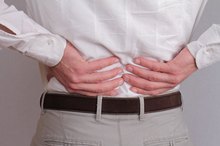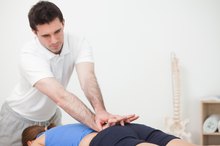Bruised Tailbone From Cycling
Cycling can help improve cardiovascular fitness, lung health and muscle strength, but it also has the potential to cause tailbone pain. Without rest and treatment, the condition could get worse and even become chronic, so it’s important to take action when you first start to feel pain. With a few precautions, you should be able to continue to enjoy the benefits of bicycling without further problems.
If you are experiencing serious medical symptoms, seek emergency treatment immediately.
Identification
The tailbone, which is called the coccyx, consists of a group of five small bones at the base of the spine that form a triangular shape and join the spine to the pelvis. The medical term for pain in the coccyx area is coccygodynia.
Causes of Bruising
Pelvic Pain & Bike Riding
Learn More
If you cycle regularly, the repetitive motion of constantly leaning forward can stretch the base of your spine and strain the muscles and ligaments around the coccyx. This motion, in addition to holding a forward-leaning position for a long period, leads to inflammation. Over time, your muscles may no longer be able to hold your coccyx in the normal position. Women also have a higher risk because they have a wider pelvis than men.
- If you cycle regularly, the repetitive motion of constantly leaning forward can stretch the base of your spine and strain the muscles and ligaments around the coccyx.
Symptoms
The main symptom is pain localized to the tailbone region, although the pain may radiate from the coccyx down into the lower pelvis and even into your thighs or lower legs. The pain is often worse while sitting or moving from sitting to standing up, during a bowel movement, during sex, or while bending or lifting heavy objects. Diagnosis is usually made with an x-ray, CT or MRI scans, or by rectal examination.
Treatments
Does Arthritis Cause Pain in the Tailbone Area?
Learn More
Ice is best to use right after injury. Apply for 15 to 20 minutes at a time during the following 48 hours. Heat is also helpful and your doctor may use special heat-producing diathermy or ultrasound in his office, although you can also use home treatments including warm compresses, a heating pad or sitting in a warm water bath for 15 to 20 minutes every hour. Pain relievers may help, as can injections of nerve blockers. Use a “donut” cushion while sitting and also stool softeners if you experience pain from bowel movements. Very rare cases may require surgical removal of the coccyx.
- Ice is best to use right after injury.
- Use a “donut” cushion while sitting and also stool softeners if you experience pain from bowel movements.
Time Frame
A bruised tailbone may take several days or weeks to heal completely. In cases where the tailbone is actually fractured, you may need to stay in bed for a day or two; the healing process can take four to six weeks. You can return to your normal activities when pain has improved and you are able to sit, bend and walk without pain.
Prevention
A French study, published in the journal “Spine” in December 2000, showed that being obese and having a high body mass index is a contributing factor in tailbone bruising and pain 2. Losing weight may not prevent coccydynia completely, but it can reduce your risk. Eat a diet rich in calcium and vitamin D to promote bone health, and use weight-bearing exercises to strength muscles and encourage strong bones.
Related Articles
References
- “American Journal of Physical Medicine and Rehabilitation”; Successful Injection for Coccyx Pain; Patrick M. Foye, et al.; September 2006
- Spine Universe: Coccydynia Tailbone Pain; December 2009
- Summit Medical Group; Tailbone Injuries; Pierre Rouzier, M.D.; 2009
- Blocker O, Hill S, Woodacre T. Persistent coccydynia--the importance of a differential diagnosis. BMJ Case Rep. 2011;2011:bcr0620114408. doi:10.1136/bcr.06.2011.4408
- Foye PM, Abdelshahed DM, Kamrava E, Enriquez R, D'onofrio GJ. Tailbone Pain from Coccyx Injuries on Water Slides: A Case Series. J Emerg Med. 2018;55(2):e33-e35. doi:10.1016/j.jemermed.2018.04.033
- Young JD, Gelbs JC, Zhu DS, Gallacher SE, Sutton KM, Blaine TA. Orthopaedic Injuries in Equestrian Sports: A Current Concepts Review. Orthop J Sports Med. 2015;3(9):2325967115603924. doi:10.1177/2325967115603924
- Márquez-carrasco ÁM, García-garcía E, Aragúndez-marcos MP. Coccyx pain in women after childbirth. Enferm Clin. 2019;29(4):245-247. doi:10.1016/j.enfcli.2019.01.005
- Gonnade N, Mehta N, Khera PS, Kumar D, Rajagopal R, Sharma PK. Ganglion impar block in patients with chronic coccydynia. Indian J Radiol Imaging. 2017;27(3):324–328. doi:10.4103/ijri.IJRI_294_16
- Faubion SS, Shuster LT, Bharucha AE. Recognition and management of nonrelaxing pelvic floor dysfunction. Mayo Clin Proc. 2012;87(2):187–193. doi:10.1016/j.mayocp.2011.09.004
- Uglialoro AD, Beebe KS, Hameed M, Benevenia J. A rare case of intraosseous benign notochordal cell tumor of the coccyx. Orthopedics. 2009;32(6):445. doi:10.3928/01477447-20090511-22
- Nunes LF, Castro Neto AK, Vasconcelos RA, et al. Carcinomatous degeneration of pilonidal cyst with sacrum destruction and invasion of the rectum. An Bras Dermatol. 2013;88(6 Suppl 1):59–62. doi:10.1590/abd1806-4841.20132140
- Dudareva M, Ferguson J, Riley N, Stubbs D, Atkins B, McNally M. Osteomyelitis of the Pelvic Bones: A Multidisciplinary Approach to Treatment. J Bone Jt Infect. 2017;2(4):184–193. doi:10.7150/jbji.21692
- Saleem S, Aslam HM, Rehmani MA, Raees A, Alvi AA, Ashraf J. Lumbar disc degenerative disease: disc degeneration symptoms and magnetic resonance image findings. Asian Spine J. 2013;7(4):322–334. doi:10.4184/asj.2013.7.4.322
- Jeyarajah S, Purkayastha S. Proctalgia fugax. CMAJ. 2013;185(5):417. doi:10.1503/cmaj.101613
- Lirette LS, Chaiban G, Tolba R, Eissa H. Coccydynia: an overview of the anatomy, etiology, and treatment of coccyx pain. Ochsner J. 2014;14(1):84–87.
- Malanga GA, Yan N, Stark J. Mechanisms and efficacy of heat and cold therapies for musculoskeletal injury. Postgrad Med. 2015;127(1):57-65. doi:10.1080/00325481.2015.992719
- Scott KM, Fisher LW, Bernstein IH, Bradley MH. The Treatment of Chronic Coccydynia and Postcoccygectomy Pain With Pelvic Floor Physical Therapy. PM R. 2017;9(4):367-376. doi:10.1016/j.pmrj.2016.08.007
- Antoniadis A, Ulrich NH, Senyurt H. Coccygectomy as a surgical option in the treatment of chronic traumatic coccygodynia: a single-center experience and literature review. Asian Spine J. 2014;8(6):705–710. doi:10.4184/asj.2014.8.6.705
- Foye PM. Coccydynia: Tailbone Pain. Phys Med Rehabil Clin N Am. 2017 Aug;28(3):539-49.
- Lirette LS, Chaiban G, Tolba R, Eissa H. Coccydynia: An Overview of the Anatomy, Etiology, and Treatment of Coccyx Pain. Ochsner J. 2014 Spring;14(1):84-87.
- Nathan ST, Fisher BE, Roberts CS. Coccydynia: a review of pathoanatomy, aetiology, treatment and outcome. J Bone Joint Surg Br. 2010 Dec;92(12):1622-7.
Resources
Writer Bio
Bonnie Singleton has been writing professionally since 1996. She has written for various newspapers and magazines including "The Washington Times" and "Woman's World." She also wrote for the BBC-TV news magazine "From Washington" and worked for Discovery Channel online for more than a decade. Singleton holds a master's degree in musicology from Florida State University and is a member of the American Independent Writers.









